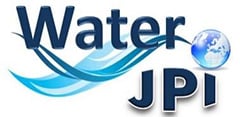Blue Nature-based Solutions in and of Cities
by Thilo Wellmann & Dagmar Haase, Humboldt-Universität zu Berlin
Urban waterbodies, such as lakes, rivers, and ponds, are essential components of our cities and towns. They not only add to the aesthetic value of our urban landscapes but also provide a range of ecosystem services for the urban quality of life, such as regulating water quality, mitigating flood risk, and supporting biodiversity (Haase, 2015). Biodiversity in urban waterbodies is particularly important as it provides several benefits that are essential for maintaining healthy and functional ecosystems. In this blog post, we focus on the interaction of green and blue components with build urban infrastructure – forming so called social-ecological-technological systems (SETs; McPhearson et al., 2016).
Urban waterbodies are often impacted by urbanization, pollution, and climate change. Therefore, it is essential to protect and conserve these aquatic ecosystems to ensure their long-term health and resilience so that they are able to provide ecosystem services and underpin ecological function in altered urban ecosystems. This can be achieved through a range of strategies, such as improving water quality, restoring degraded riverine ecosystems, and promoting the use of green, sometimes grey-green infrastructure (Pauleit et al., 2019). It is also important to engage local communities and stakeholders in the conservation and management of urban waterbodies to ensure that aquatic ecosystems are valued and protected.
Central in these protection efforts are nature-based solutions (NbS), which are strategies and actions that use ecosystem structures and processes to address societal challenges, such as climate change, health risks, or biodiversity loss. A central form of NbS is green and blue infrastructure (GBI), which is a network of natural and semi-natural spaces, such as parks, green roofs, and urban forests, that provide ecosystem services in urban areas (Pauleit et al., 2019). GBI can positively impact biodiversity through the creation of wetlands and ponds as part of green-blue infrastructure providing breeding grounds for aquatic species, and riparian vegetation that provides shade and food for aquatic organisms. In addition, green-blue infrastructure can also contribute to the regulation of water quality and quantity when fixing pollutants and lowering runoff velocity (Xu et al., 2020), which is essential for maintaining healthy and functional ecosystems of whole cities.
There is a wide range of actions to support biodiversity in and among GBI. These can be actions of restoration or changing built for green infrastructure. Restoration actions can revitalise ecosystems that have been degraded or destroyed by human activities, such as aforementioned pollution or urbanization. For example, the restoration of riparian vegetation along urban waterways can provide habitat for fish, birds, and other aquatic organisms. While traditional stormwater management systems, such as concrete channels and pipes, can negatively impact natural hydrological processes that are essential for maintaining healthy and functional ecosystems, nature-based stormwater management solutions, such as constructed wetlands, rain gardens, and permeable pavements, can positively impact urban hydrological processes up to the entire water cycle (Guererro et al., 2017). Through improved infiltration and retention of stormwater less built infrastructure in cities is needed allowing green infrastructure to provide more co-benefits to both biodiversity and society potentially ending up in more nature-based infrastructure.
Next to biodiversity, urban waterbodies provide opportunities for urban residents to engage with nature, and this can have positive impacts on mental health and wellbeing of the people. NbS and GBI can provide important social benefits by supporting the social functions of water bodies, for instance, biodiversity can enhance the recreational value of urban water bodies by supporting a diversity of fish and wildlife species that can be enjoyed by anglers, birdwatchers, and other outdoor enthusiasts. A diverse range of aquatic plant species can also contribute to the aesthetic value of water bodies, enhancing their visual appeal and creating a more immersive natural environment for recreational activities (Pinho et al., 2023).
Thus, biodiversity in and around urban water bodies can be of value for human-nature interactions. Healthy ecosystems can be the foundation for activities like swimming or fishing in and around cities. Also, the presence of diverse fish and aquatic invertebrate species can provide opportunities for environmental education, while the presence of rare or threatened species can help to raise awareness about the importance of biodiversity conservation. The presence of culturally significant fish species or aquatic plants can help to reinforce the connection between water bodies and local communities. Biodiversity in urban water bodies can contribute to the social functions of these water bodies in a variety of ways, enhancing their value as important components of urban ecosystems and contributing to community well-being and quality of life.
Critical for social functions is the location of the water body as well as the interaction with the surroundings. Water bodies located in the city centre may have different spatial characteristics than those located in the urban periphery. The land-use surrounding urban water bodies defines their potential to provide ecosystem services, so for example, water bodies surrounded by parks and natural areas may more effectively reduce runoff or filter pollutants compared to those surrounded by urban grey infrastructure and sealed surfaces.
Important for social functions as well as for the benefits for biodiversity is the connectivity of urban water bodies. Water bodies that are connected to larger river systems or other water bodies may offer different supporting functions for biodiversity compared to those that are pipe-fed. Further, depth of urban water bodies and the features of their shorelines can also impact their functions. What is more, the ecosystem services provided by biodiversity in urban waterbodies can have direct economic benefits, such as reducing the costs of flood control. These functions can be expanded through the integration of NbS into water management, by planning for green-blue infrastructure mixed with grey multifunctionality.
The spatial embeddedness of NbS can have important implications for their ecological and social functions, as well as for their resilience and adaptability to changing urban conditions (Wellmann et al., 2023). Understanding these spatial aspects can help to inform management and conservation efforts, and ensure that urban water bodies are valued and protected as important components of urban ecosystems. Healthy urban waterbodies are essential for maintaining the health and resilience of our cities. These ecosystems provide a range of ecosystem services, including water purification, climate regulation, and cultural and economic value. Therefore, it is essential to protect and conserve these ecosystems to ensure their long-term health and sustainability. By planning for multifunctionality using nature-based solutions in and of cities, we can create cities that are not only liveable but also sustainable, resilient, and biodiverse.
Much of this we can observe in the city of Berlin, Germany, in which we would like to invite you to take a short tour, showing some facets blue NbS can have in cities rich in green-blue infrastructure (Wellmann et al., 2020).
A tour through the diverse blue NbS landscape of Berlin
All photos taken by Thilo Wellmann
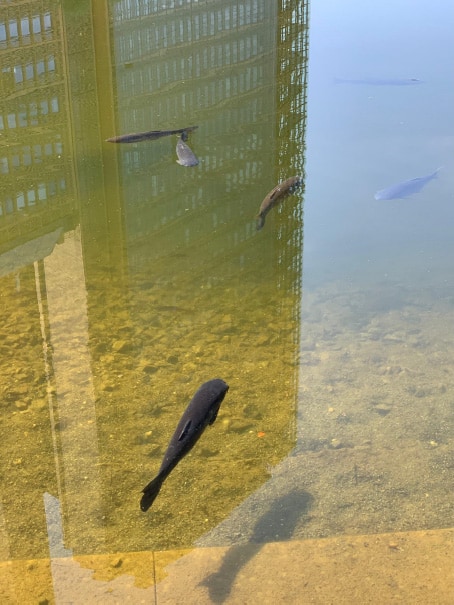
Renzo Piano Teich – a truly urban pond.
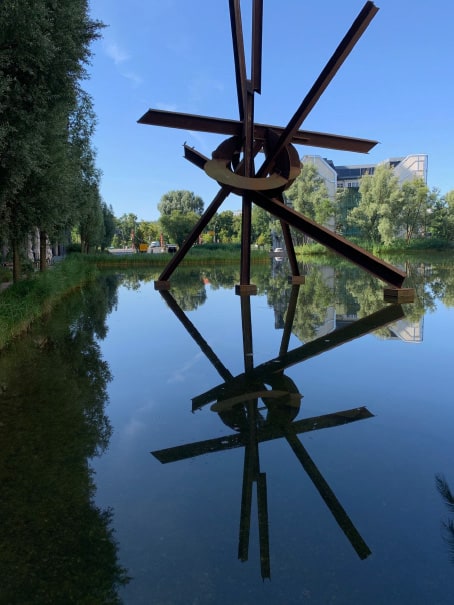
Renzo Piano Teich 2
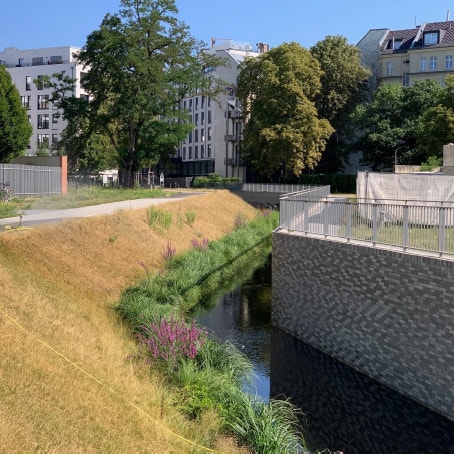
Südpanke – a re-discovered river between spies and Gründerzeit.
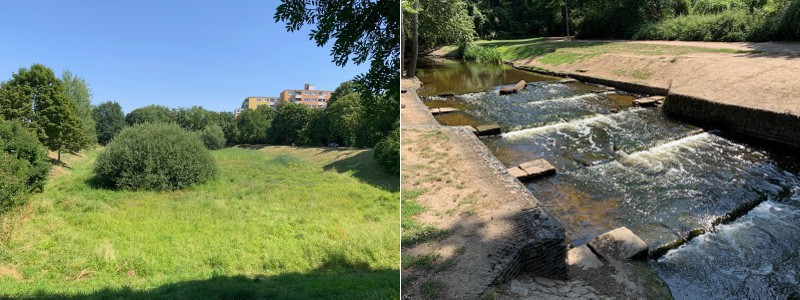
Along the Panke – where the passer-by fish are welcome again and flood protection is built right into the parks space.
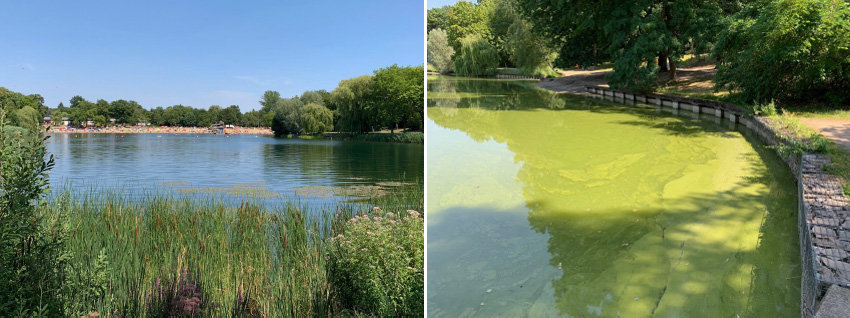
Orankesee and Obersee – located right next to each other but with very different water quality and use.

Wuhle – where renaturation was successful but then the river went missing.
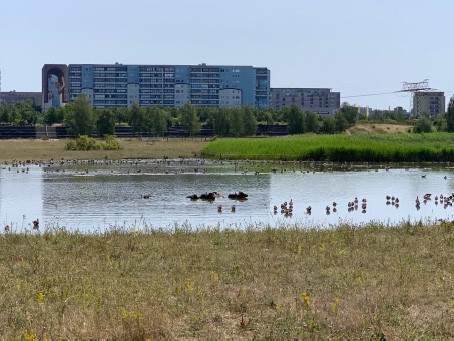
Between highway and buildings from former times – there lies the landscape park Rudow-Altglienicke
References
Guerrero P, Haase D, Albert C 2018. Locating spatial opportunities for nature-based solutions: a river landscape application. Water 10, 1869; https://doi.org/10.3390/w10121869
Haase D 2015 Reflections About Blue Ecosystem Services in Cities. Sustainability of Water Quality and Ecology. Available online http://www.sciencedirect.com/science/article/pii/S2212613915000112.
McPhearson T Pickett S, Grimm N, Niemelä J, Elmqvist T, Weber C, Breuste J, Haase D, Qureshi S. 2016. Ecology for an Urban Planet: Advancing Research and Practice Towards a Science of Cities. BioScience. https://doi:10.1093/biosci/biw002.
Pauleit S, Anton S. Olafsson, Emily Rall, Alexander van der Jagt, Bianca Ambrose-Oji, Erik Andersson, Barbara Anton, Arjen Buijs, Dagmar Haase, Birgit Elands, Rieke Hansen, Ingo Kowarik, Jakub Kronenberg, Thomas Mattijssen 2019. Urban green infrastructure in Europe – status quo, innovation and perspectives. Urban Forestry and Urban Greening. Urb Forest Urb Green. 40(4), 4-16. https://doi.org/10.1016/j.ufug.2018.10.006.
Pinho et al. 2023. Urban aquatic nature-based solutions in a context of global change: Uncovering the social-ecological-technological framework. Forthcoming.
Xu Chao, Mohammad Rahman, Dagmar Haase, Yiping Wu, Meirong Su, Stephan Pauleit. 2020. Surface runoff under different urban dynamics: The role of residential cover and urban growth form. Journal of Cleaner Production 121421. https://doi.org/10.1016/j.jclepro.2020.121421
Wellmann, T., E. Andersson, S. Knapp, A. Lausch, J. Palliwoda, J. Priess, S. Scheuer, and D. Haase. 2023. Reinforcing nature-based solutions through tools providing social-ecological-technological integration. Ambio 52: 489–507. https://doi.org/10.1007/s13280-022-01801-4
Wellmann, T., F. Schug, D. Haase, D. Pflugmacher, and S. van der Linden. 2020. Green growth? On the relation between population density, land use and vegetation cover fractions in a city using a 30-years Landsat time series. Landscape and Urban Planning 202. Elsevier: 103857. https://doi.org/10.1016/j.landurbplan.2020.103857
Note: A first draft of this blogpost was based on answers provided by ChatGPT. Answers were checked and vastly rewritten.
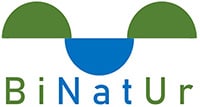
Project funders:
This research was funded through the 2020-2021 Biodiversa and Water JPI joint call for research projects, under the BiodivRestore ERA-NET Cofund (GA N°101003777), with the EU and the funding organisations The Research Foundation - Flanders (FWO), Belgium; Academy of Finland (AKA), VDI/VDE-IT, Germany; National Science Center (NCN), Poland and Fundação para a Ciência e Tecnologia (FCT), Portugal

